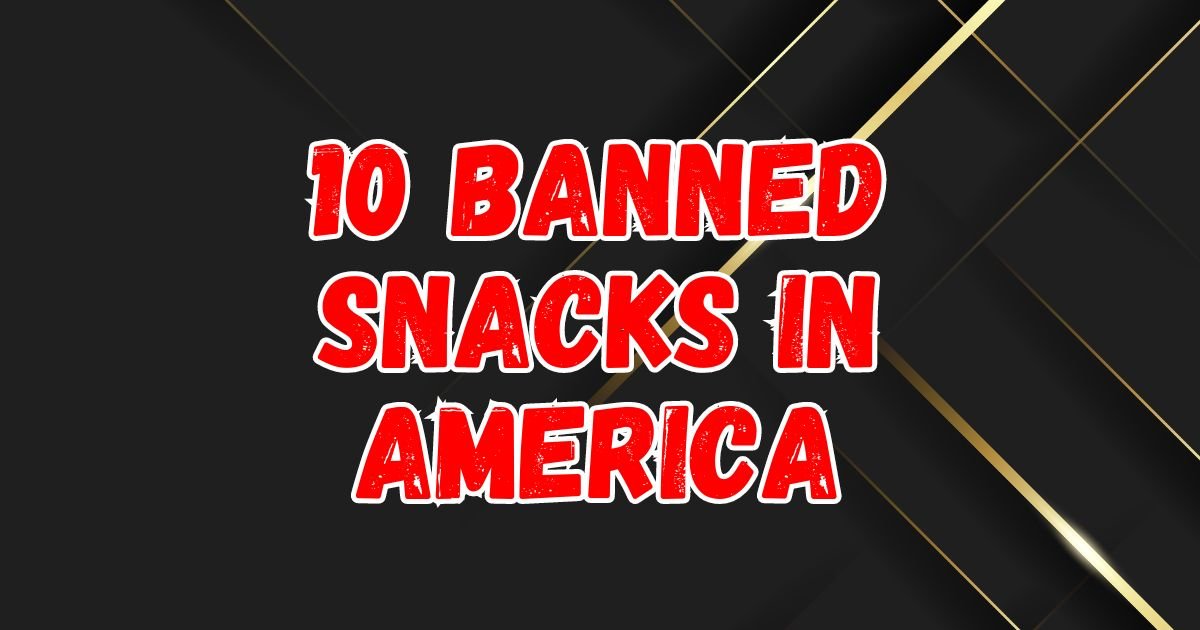When it comes to snacks, America is home to a diverse range of flavors and innovations. However, not all snacks have made the cut. Over the years, certain snacks have been banned due to health concerns, regulatory issues, or controversial ingredients. In this blog post, we’ll explore ten shocking banned snacks in America, delve into the reasons behind these bans, and what they teach us about food safety in the country.
What Are Banned Snacks?
Banned snacks are food items that have been prohibited from sale or distribution in the United States. The reasons for these bans often include health risks associated with certain ingredients, failure to meet safety regulations, or concerns about the manufacturing processes. These snacks might still be available in other countries, leading to curiosity about their ingredients and effects. Understanding why these snacks were banned helps consumers make informed choices about what they eat.
Why Are Snacks Banned in the USA?
The primary reasons snacks get banned in the USA often relate to health risks and safety concerns. The Food and Drug Administration (FDA) and other regulatory bodies ensure that food products meet certain safety standards. If a snack is found to contain harmful ingredients or poses a risk to consumer health, it may be banned.
Health risks can arise from various factors, including the presence of unsafe additives, excessive sugar or salt levels, or ingredients that have been linked to serious health issues. Additionally, some snacks may be banned due to lack of transparency in labeling or manufacturing practices that do not adhere to food safety regulations.
Health Risks and Safety Concerns
One of the main reasons for banning certain snacks is their potential health risks. For example, snacks containing high levels of trans fats, artificial colors, or preservatives may be associated with serious health conditions. Studies have linked trans fats to heart disease, prompting regulatory bodies to restrict their use in food products. When manufacturers fail to comply with these regulations, snacks can be banned to protect public health.
Moreover, ingredients that pose allergenic risks can also lead to bans. For instance, if a snack is found to contain undeclared allergens, it may be pulled from the market to prevent adverse reactions among consumers.
Regulatory Bodies Involved in Food Safety
In the United States, multiple agencies work to ensure food safety. The FDA plays a crucial role in regulating food products, while the United States Department of Agriculture (USDA) oversees meat, poultry, and processed egg products. These organizations are responsible for enforcing safety standards and monitoring food products for compliance.
When a snack is found to violate safety regulations, these agencies can issue recalls or bans. Their mission is to protect public health and ensure that consumers have access to safe food options.
Popular Banned Snacks and Their Stories
Many popular snacks have faced bans over the years. Here are ten examples that might surprise you.
Snack #1: Doritos (Certain Flavors)
Some flavors of Doritos have faced bans due to their ingredients. For instance, the “Cool Ranch” variety was scrutinized for containing artificial colors and preservatives linked to health concerns. While they may still be available in other countries, certain flavors were removed from the American market to comply with health regulations.
Snack #2: Frito Lay’s Lays (Flavored Varieties)
Certain flavored Lays chips, particularly those containing high levels of MSG (monosodium glutamate), have been banned due to their association with health issues, including headaches and allergic reactions. The controversy around MSG has led to heightened scrutiny of snacks containing this ingredient.
Snack #3: Cheetos (Certain Limited Editions)
Some limited-edition Cheetos have been banned due to the inclusion of synthetic food dyes, which have been linked to hyperactivity in children. As parents become more aware of these concerns, snacks with controversial ingredients face increasing pressure to change or be removed from the shelves.
Snack #4: Kinder Surprise Eggs
While not a traditional snack, Kinder Surprise Eggs have faced bans in the U.S. due to safety regulations regarding toys inside food items. The FDA considers the combination a choking hazard for young children, leading to the eggs being banned, despite their popularity in other countries.
Snack #5: Red Bull (Certain Formulations)
Some formulations of Red Bull have faced scrutiny due to high caffeine levels and the inclusion of certain additives. The FDA has investigated the health implications of energy drinks, leading to temporary bans on specific formulations that did not meet safety standards.
Snack #6: Unapproved Foreign Snacks
Various snacks from other countries, such as certain types of candy or chips, have been banned in the U.S. due to unapproved additives or ingredients. For example, snacks containing certain artificial sweeteners or colorings that are banned in the U.S. might still be popular in their home countries.
Snack #7: British Chocolate Bars
Some British chocolate bars, known for their unique flavors and ingredients, have faced bans in America due to safety concerns. Ingredients that are permissible in the UK may not meet U.S. standards, leading to the prohibition of these treats in the American market.
Snack #8: Certain Flavored Ice Creams
Some flavored ice creams have been banned due to the presence of artificial flavoring and coloring agents that do not comply with FDA regulations. For example, certain “fun” flavors that contain unapproved ingredients may not make it to American shelves.
Snack #9: Popular International Chips
Several brands of chips from abroad have faced bans for containing high levels of unhealthy additives. These chips, while popular in their countries of origin, may not pass U.S. health regulations, leading to their removal from the market.
Snack #10: Energy Gummies
Some brands of energy gummies have been banned due to high caffeine content and the use of synthetic additives. With growing awareness of the health risks associated with excessive caffeine, these products faced scrutiny and ultimately removal from store shelves.
Controversial Ingredients That Lead to Bans
As we’ve seen, many snacks have been banned due to their controversial ingredients. Common issues include the use of artificial colors, flavors, and preservatives that are not compliant with FDA standards. Additionally, snacks containing trans fats or excessive sugars can lead to serious health risks and regulatory action.
The growing trend of health-conscious consumers has pushed manufacturers to reconsider the ingredients they use. As more people prioritize clean eating and transparency, snacks that fail to meet these demands are likely to face increased scrutiny and potential bans.
The Impact of Banned Snacks on Consumer Choices
The bans on certain snacks have a significant impact on consumer choices. As awareness grows about health risks associated with specific ingredients, consumers are becoming more discerning about what they eat. Many people are opting for healthier alternatives and avoiding snacks that contain controversial additives.
These changes have led to a shift in the snack market. Companies are reformulating their products to comply with safety standards and cater to health-conscious consumers. The demand for natural ingredients and transparency in labeling is reshaping the landscape of snack foods.
What Can We Learn from Banned Snacks?
The story of banned snacks teaches us valuable lessons about food safety and consumer awareness. First, it highlights the importance of regulatory bodies in protecting public health. These agencies work tirelessly to ensure that food products meet safety standards, and their actions are crucial in preventing harmful snacks from reaching consumers.
Second, the bans underscore the need for transparency in food labeling. Consumers should be aware of what they are eating and the potential risks associated with certain ingredients. This awareness encourages manufacturers to produce safer, healthier snacks.
Finally, the phenomenon of banned snacks serves as a reminder of the power of consumer choice. As more people advocate for healthier options, companies are compelled to listen. The trend towards clean eating is reshaping the snack industry, and we can expect to see more innovative products that prioritize health and safety.
Conclusion
The world of snacks is vast and varied, but it is essential to recognize that not all snacks are created equal. Many popular snacks have been banned in America for valid reasons related to health and safety. Understanding these bans helps consumers make informed choices and fosters a culture of transparency and safety in the food industry.
By being aware of the reasons behind these bans and advocating for healthier options, we can all contribute to a safer and healthier food environment. Let’s continue to prioritize our health and make informed choices about the snacks we consume.
FAQs About Banned Snacks in America
1. Why are some snacks banned in America?
Snacks are banned due to health risks, unsafe ingredients, or failure to meet safety regulations.
2. Who regulates food safety in the U.S.?
The FDA and USDA are the primary agencies responsible for food safety in the United States.
3. Can banned snacks still be found in other countries?
Yes, many banned snacks in America are still available in other countries, where regulations may differ.
4. What should I look for when choosing snacks?
Look for transparency in labeling, avoid artificial additives, and prioritize snacks with natural ingredients.
5. Are there any recent trends in snack bans?
Yes, there is a growing trend towards banning snacks with excessive sugars, unhealthy additives, and controversial ingredients as consumer awareness increases.

Evelyn White is an experienced content writer with a background in lifestyle, trends, and practical advice. With several years of writing across digital platforms, she specializes in making everyday topics accessible, informative, and engaging. Her goal is to deliver trustworthy, reader-focused content that’s both useful and easy to understand.
Discover more from Try Hard Guides
Subscribe to get the latest posts sent to your email.

